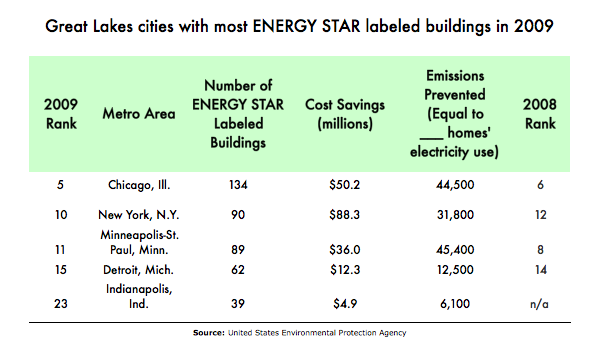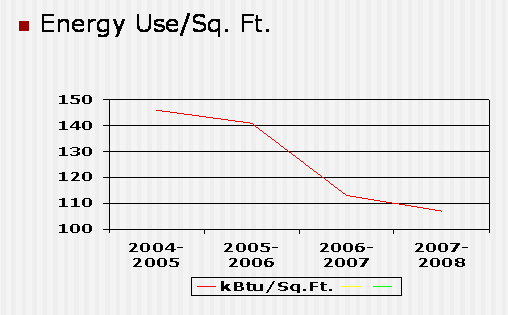 An Indiana elementary school’s third-graders are taking a hands-on approach to learning about efficient energy use.
An Indiana elementary school’s third-graders are taking a hands-on approach to learning about efficient energy use.
Mount Tabor Elementary School students in the Energy Club periodically measure classroom energy savings and award big, yellow stars to those that pass the inspection.
Scott Burch, a teacher at the school, started the club after Mount Tabor earned the federal government’s Energy Star label for buildings in 2006.
Burch measures energy use to teach students about efficiency, said Jim Thaxton, an energy auditor for the New Albany-Floyd County School Corp.
“That’s his goal for his students – to take this home with them,” Thaxton said.
Schools make up nearly half of Energy Star-labeled buildings in the Great Lakes region, according to U. S. Environmental Protection Agency data.
Cities in five Great Lakes states also made the agency’s list of metropolitan areas with the most energy-efficient buildings.
With 134 labeled buildings, Chicago, Ill. ranks fifth on the top 25 list. The structures have saved an estimated $50.2 million.
New York and Michigan lead the region as states with the most buildings with the label, according to agency data.
The Energy Star program initially recognized energy-efficient consumer products. It expanded in 1999 to include buildings and later schools and supermarkets.
Only 14 buildings in the region earned the label in 1999, said Maura Beard, communications director for the program. Now more than 2,000 buildings are considered energy efficient by federal standards.
To earn the Energy Star label for a building, an organization must assess past energy use, set goals and continually monitor progress, according to the agency.
Buildings with the Energy Star use 35 percent less energy than traditional buildings, emit less carbon and cost half as much per square foot to operate, Beard said.
“There’s a growing awareness of the environmental problem of climate change and a growing concern that we need to all do out part to help find solutions that are good for the environment and good for the bottom line,” she said.
EFFICIENT EDUCATION

Energy use at the New Albany–Floyd County Consolidated School Corp. has decreased since 2004 due to effciency programs.
New Albany, Ind. – home of Mount Tabor Elementary School – has the most energy-efficient buildings in one area, according to agency data. That’s because nearly all of the schools in the district carry the Energy Star label.
Since 2002, there has been an effort within the New Albany-Floyd County School Corp. to make all schools energy-efficient, Thaxton said.
New Albany schools average a 95 percent rating on the agency’s Energy Star scale, Thaxton said. That puts them in the top 5 percent of the country.
It costs the schools 94 cents per square foot to operate. That’s less than the national average of $1.43.
But the schools had to start small to reach that level of energy savings, Thaxton said. Before investing in costly technologies, staff had to make behavioral changes like powering down electronics when not using them.
“We had to have initiatives in place,” he said.
Ensuring the entire organization is committed to changing energy inefficient practices is the core element of the Energy Star program, Beard said.
“We found that making those expensive purchases without understanding how you’re performing and making all those operational behavioral changes first isn’t the best way to approach energy efficiency,” she said.
RICH RETAIL
More retailers and supermarket chains are also earning the Energy Star label. They currently make up a quarter of labeled locations in the region.
Half of Kohl’s department stores have earned the Energy Star label in the last decade. That’s the most in the region for retailers.
A third of JC Penny department stores have the Energy Star, according to the data.
The company realized it was wasting energy by turning air conditioners on before the stores opened and turning them off significantly after the stores closed, Beard said.
“Paying attention to how much you’re using and tracking can make a big difference in your operation,” she said.
STREAMLINED SUPERMARKETS
With more than 120 locations, the Giant Eagle grocery store chain – located throughout Ohio and Pennsylvania – is the largest in the region with the Energy Star label.
Buehler’s Food Markets is a smaller chain, but nearly all its locations have the rating. Out of 13 supermarket locations, 11 are Energy Star-certified, said Rebecca Foster, director of construction and maintenance of Buehler’s.
The company prides itself on sustainability, Foster said. It operates a recycling program, makes and intends on selling its own compost and runs two vehicles on French fry oil from the stores.
Buehler’s will seek certification for its last two locations after collecting enough energy-use data. The Energy Star progress can be costly, Foster said.
“It’s expensive because you have to pay the engineering fee to certify that your building is efficient,” she said. “I would say that’s the biggest obstacle and maybe why a lot of companies wouldn’t do it.”